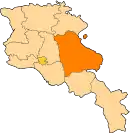Sotk
Sotk (Armenian: Սոթք, Azerbaijani: Zod) is a village in the Gegharkunik Province of Armenia, well known for its gold mines.[1] The village had an Azerbaijani population prior to the Nagorno-Karabakh conflict, when all of its Azerbaijani inhabitants were forced to flee to Azerbaijan.[2]
Sotk
Սոթք Zod | |
|---|---|
 Mountains around Sotk | |
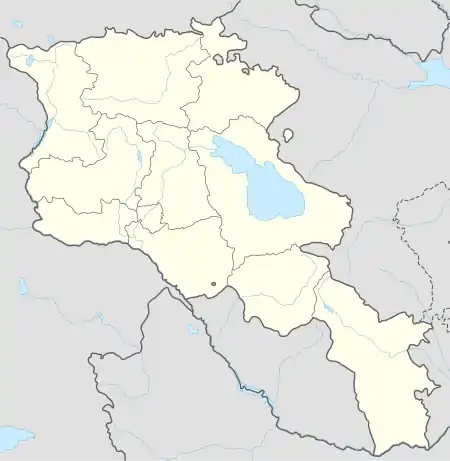 Sotk | |
| Coordinates: 40°12′11″N 45°51′53″E | |
| Country | Armenia |
| Marz (Province) | Gegharkunik |
| Founded | 15th century |
| Elevation | 2,032 m (6,667 ft) |
| Population (2008) | |
| • Total | 1,135 |
| Time zone | UTC+4 ( ) |
Etymology
According to J. Markwart and N. Adonts, the name Sotk may be connected to the name of a tribe called Tsavde (atsvots) mentioned in ancient Armenian sources,[3] while others connect it with the toponym Suta (or Shuta) of the Hittite sources [3] (the presence of the Hittites was proposed in the vicinity of Lake Sevan in 2009[4]).
History
Sotk has been well known for its mines throughout its history. The mines may have been exploited as early as the 2nd millennium BC, evidenced by the discovery of pits, funnels covered with grass, underground workings, wooden tools, stone mortars, washing pots, and more. The mines were used with interruptions until the 14th century AD, and later rediscovered in the 20th century.
Bronze Age
Materials, cemeteries, weapons, bones, and everyday life objects, belonging to the early Bronze Age, have been found in complexes of settlements around the Sotk mountain pass.[5] During this time, gold may have been acquired by alluvial way, while real mining may have begun in the later Bronze Age.[6]
On the southern slope of the mine, ruins of a large ancient settlement are visible, from where a grass-covered path led to the mine (in 1954, this path would be turned into a road for miners). The river valley is covered by artificial oval terraces which steep from the side towards the river flow.[7] West of Sotk, around the nearby town of modern Vardenis, are some cyclopean fortresses, with corresponding cemeteries from the 2nd and 1st millennium BC, among which is Tsovak, where there is a cuneiform inscription by Urartian king Sarduri II. To the north is a settlement of the Kura-Araxes culture. Many other such ruins can be found near Sotk, such as in Chambarak, indicating the Lake Sevan basin was a significant region, controlled from centers like Ishtikuni (Lchashen) and confederations of chiefdoms, such as the Uduri-Etiuni (which seems to be at least partially Armenian etymologically) mentioned in Urartian sources. Elite tombs in Lchashen were rich with gold, which, according to metallurgical analyses, would have derived from Sotk.[8]
Antiquity to Middle Ages
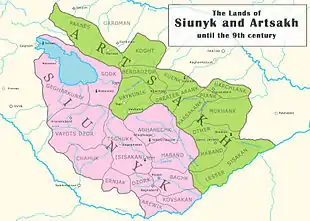
At some point during the late Iron Age, the highlands known as "Urartu" became known as "Armenia" (see Urartu § Fall). As the first Armenian political entity expanded eastwards, the regions around Sotk were incorporated as core regions of ancient Armenia.
During Antiquity and the Middle Ages, Sotk was part of Syunik, one of the regions of the ancient and the medieval kingdoms of Armenia, where it served as the capital of the region of the same name. Its location on the mountain pass was at a strategic point on the medieval Dvin-Partav road, connecting the southern and eastern regions of the South Caucasus.[7]
The 7th century St. Astvatsatsin Church, an Armenian basilica church with 13th century khachkars in its walls is located in the village.[9][10]
Demographics
According to Brockhaus and Efron Encyclopedic Dictionary at the end of the 19th century, the village of Zod had 1,088 Tatar (now known as Azerbaijanis) inhabitants.[11]
According to the "Caucasian calendar" of 1912, 1,778 people lived in the village of Zod, mostly "Tatars" (now known as Azerbaijanis).[12]
In 1988, the entire Azerbaijani population of the village fled and were expelled as a result of the Nagorno-Karabakh conflict. Their homes were repopulated by Armenian refugees from Azerbaijan.[2]
Gold mine
A gold mine near the village, called Zod by the Azerbaijanis, is one of the largest gold deposits in the South Caucasus.[13] It is located on the border of Kalbajar District in Azerbaijan and Gegharkunik Province in Armenia.[14] Kalbajar District was administrated by the self-proclaimed Republic of Artsakh from its occupation by the Armenian forces in 1993 after the Battle of Kalbajar, near the end of the First Nagorno-Karabakh War,[15] until 2020, as the Armenian side handed it over to Azerbaijan according to the ceasefire agreement, ending the Second Nagorno-Karabakh war.[16] The Azerbaijani forces entered the district on 25 November,[17] and on 26 November, the Armenian media reported that a group of 250 Azerbaijani soldiers had arrived at the gold mine, and demanded its handover,[18] establishing a military post at the mine.[19] The Armenian defense ministry refuted this account,[20] stating that Azerbaijani forces, having found an Armenian border checkpoint unacceptable, contacted the Armenian side via loudspeaker and negotiated with Russian peacekeepers over the issue. Armenian and Azerbaijani authorities started to demarcate the border on the same day.[21] Armenian military authorities then stated that half of the mine area had been passed to Azerbaijan.[22]
Gallery
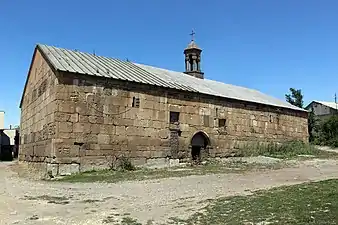 7th century St. Astvatsatsin Church in Sotk
7th century St. Astvatsatsin Church in Sotk.jpg.webp) Railroad station in Sotk
Railroad station in Sotk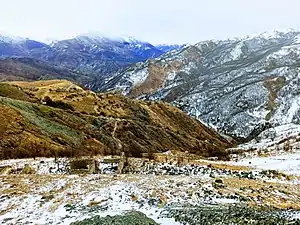 Nature around Sotk
Nature around Sotk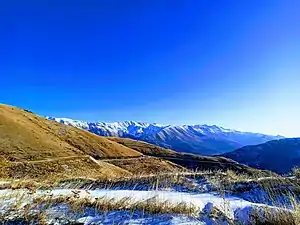 Nature of Sotk
Nature of Sotk Khachkar from the St. Astvatsatsin Church in Sotk
Khachkar from the St. Astvatsatsin Church in Sotk
Notable people
- Ahliman Amiraslanov (born 1947), professor and Rector of Azerbaijan Medical University.
See also
References
- Kiesling, Brady; Kojian, Raffi (2005). Rediscovering Armenia: Guide (2nd ed.). Yerevan: Matit Graphic Design Studio. p. 82. ISBN 99941-0-121-8.
- "Waiting to go home: The plight of Nagorno-Karabakh's refugees". reliefweb.int. ReliefWeb. 3 June 2003. Archived from the original on 15 July 2006.
- Hakobyan T.Ch., Melik-Bakhshyan S.T., Barseghyan H.Ch., Hayastani ev harakits shrjanneri teghanunneri bararan (Toponymical Dictionary of Armenia and Surrounding Regions), v. 2, 313, Yerevan, 1988-2001.
- Petrosyan A., The ‘Eastern Hittites’ in the South and East of the Armenian Highland? Armenian Journal of Near Eastern Studies IV/1 (2009), pp. 63-72
- Xnkikyan O.S. (1977). Arhestnery bronzedaryan Hayastanum (Crafts in Bronze Age Armenia). Yerevan. p. 14.
- Gevorgyan A., Zalibekyan М. (2007). Kalantaryan. p. 30.
- Aram Gevorgyan, Arsen Bobokhyan "METALLURGY OF ANCIENT ARMENIA IN CULTURAL AND HISTORICAL CONTEXT", Armenian National Academy of Sciences. Retrieved on 1 May 2018.
- Xnkikyan O.S. (1977). Arhestnery bronzedaryan Hayastanum (Crafts in Bronze Age Armenia). Yerevan. p. 18.
- https://issuu.com/svetlanadingarac/docs/gegharkunik_guide_book-3
- https://ostarmenia.com/hy/gegharqunik-%D5%A3%D5%A5%D5%B2%D5%A1%D6%80%D6%84%D5%B8%D6%82%D5%B6%D5%AB%D6%84/
- "Зод, селение". Brockhaus and Efron Encyclopedic Dictionary (in Russian). Saint Petersburg. 1894. p. 624.
- "Caucasian Calendar. Tiflis 1912" (in Russian). Archived from the original on 12 October 2016.
- "Kelbajar gold deposits to remain on territory of Azerbaijan". Vestnik Kavkaza. 27 November 2020. Retrieved 27 November 2020.
- "Azərbaycan MN Zod mədəni ilə bağlı yayılan xəbərlərə şərh verməyib". BBC Azerbaijani Service (in Azerbaijani). 27 November 2020. Retrieved 27 November 2020.
- UN Resolution 884
- "Azerbaijani army enters Kalbajar, region returned by Armenia". Al Jazeera. 25 November 2020. Retrieved 27 November 2020.
- "Azerbaijani leader vows to revive region ceded by Armenia". Associated Press. 25 November 2020. Retrieved 27 November 2020.
- "Глава общины Гегамасар: «Азербайджанские ВС отошли назад в районе Сотка в Армении»". ArmenianReport. 27 November 2020. Retrieved 27 November 2020.
- "В Генштабе ВС Армении не видят поводов для волнения из-за появления азербайджанских солдат в Сотке". ArmenianReport. 27 November 2020. Retrieved 27 November 2020.
- Ghazanchyan, Siranush (26 November 2020). "Azerbaijani troops have not entered the area of Sotk gold mine – Defense Ministry". Public Radio of Armenia. Retrieved 27 November 2020.
- Aghalaryan, Kristine (26 November 2020). "Azerbaijani troops have not entered the area of Sotk gold mine – Defense Ministry". Hetq.am. Retrieved 27 November 2020.
- Ghukasyan, Seda (27 November 2020). "Half of Sotk Gold Mine Now in Azerbaijan, Says Armenian Military Official". Hetq.am. Retrieved 27 November 2020.
- Sotk at GEOnet Names Server
- World Gazeteer: Armenia – World-Gazetteer.com
- Report of the results of the 2001 Armenian Census, Statistical Committee of Armenia
- Brady Kiesling, Rediscovering Armenia, p. 82; original archived at Archive.org, and current version online on Armeniapedia.org.
